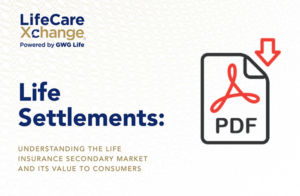Life settlement markets around the country vary dramatically in activity level and opportunity. But the disparity from state to state is anything but random. State regulations, demographics, and life insurance values all influence the relative strength of a regional life settlement market.
A new study from Harbor Life Settlements quantifies those state-to-state differences with the U.S. Life Settlement Index.

The U.S. Life Settlement Index ranks every state on seven weighted attributes that contribute positively or negatively to life settlement activity (see chart below). Those attributes are:
- Median household income. A higher median income is associated with more life settlement activity.
- Average life expectancy. A lower life expectancy positively affects life settlements. Policies insuring individuals with shorter lifespans are more attractive to investors.
- Size of the state’s population aged 75 or older. A larger population of seniors generally increases the pool of policies available on the secondary market.
- Median monthly cost of long-term care. Higher-priced long-term care costs can encourage more policyholders to consider a life settlement as a strategy to raise cash.
- Face amount of life insurance per capita. A higher face amount of life insurance per capita could mean relatively more people have life insurance or the policies held in that state have relatively higher values. Either factor benefits the life settlement market. Investors prefer higher-value policies, while a greater number of policies can supply a more robust activity level.
- Presence of state regulations on life and viatical settlements. Regulations legitimize the life settlement industry and help policyholders feel more comfortable proceeding with a life settlement.
- Whether the state requires life settlement disclosures to policyholders who are considering surrendering their life insurance. Many policyholders don’t know they can raise more cash by selling instead of surrendering their life insurance. State-mandated disclosures can encourage life settlement activity by educating policyholders about their options.
Average life expectancy and the size of the elderly population are the two highest-weighted attributes in the index, followed by life insurance value per capita and median household income.
Top 5 states for life settlements
Based on those factors, the index ranks California as the best state for life settlement opportunity. Washington, New Jersey, and Illinois rank second through fourth, and Wisconsin and Massachusetts are tied for the fifth ranking spot [see chart below for full rankings].
All six of these states regulate life and viatical settlements, and three of them mandate life settlement disclosures. Five of the six states also have above-average long-term care expenses and all six have fairly large populations of seniors aged 75 or older.
Worst 5 states for life settlements
The five worst states for life settlements are Montana, Alabama, Idaho, New Mexico, and Hawaii.
Hawaii earns the lowest spot on the index because it has the longest life expectancy of any state and no regulations on life or viatical settlements. The other four states share low median income, a shorter average life expectancy, low life insurance per capita, and more affordable long-term care costs.
Takeaways for financial professionals and investors
A strong secondary market for life insurance creates opportunities for investors, financial advisors, and insurance agents, as well as policyholders.
Investors should enjoy a more consistent supply of investable policies from those higher-ranking states. A greater number of investable policies makes it easier to diversify and build out a high-quality life settlement portfolio.
Financial professionals located in higher-ranking states can feel confident their market is evolved enough to support their clients’ needs. Particularly in states with regulations in place, advisors should consider whether a life settlement makes sense for any client who has unwanted life insurance. Showing clients how to convert that unwanted insurance into cash can pay big dividends from a reputation and relationship standpoint.
Of course, there’s also money to be made. Life settlement brokers and companies do pay referral fees. Advisors and agents can also earn fees or commissions on the reinvestment of life settlement proceeds.
As an example, an over-insured policyholder could sell a high-value policy and use the proceeds to pad an investment account under management or to buy a smaller policy.
Not all states share the same opportunity
The U.S. Life Settlement Index by Harbor Life Settlements indicates the relative strength of the secondary market for life insurance from state to state. Use it to gauge the life settlement opportunity in your region, and to inform the financial strategies you pursue for your own portfolio or those you recommend to clients.

About the Author: Lucas Siegel is the founder and CEO of Harbor Life Settlements, a life settlement company that is dedicated to helping seniors and the terminally ill sell their life insurance policies, and Harbor Life Brokerage, a life settlement broker that helps policyholders receive the maximum cash value for their life insurance through its proprietary bidding platform that reaches the world’s largest buyers.














what about Canada – has anybody done any research into the various povinces ? if not, please feel free to contact me as to what can and can't done there
Whats about London and Spain